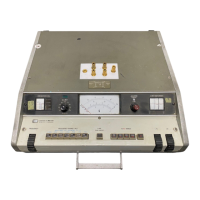Section III
Paragraphs 3-62 to 3-66
Model 4342A
Figure 3-11 (A) exhibit the stray capacities
added by connecting a sample with a shielded
case.
This capacitance increase adds to the
stray capacitances (Cl, C2 and Cs) around the
measurement terminals. In a series measure-
ment,
the shorting strap, for initially
short-circuiting the unknown connection ter-
minals, has its own residual impedance.
Additionally, its contact resistances differ
from those of samples. Small changes in the
loss and the distributed inductance of the
tuning capacitor affect measurement accura-
cies. Figure 3-11(B) graphically shows an
electrical model of a variable capacitor.
The distributed inductance and the loss
varies depending on the position of the
capacitor rotor.
In the 4342A, these re-
sidual factors are minimum because specially
designed, high quality variable capacitors
are employed in the tuning circuit.
Actually,
the residual impedances present in
the measuring circuit do not cause signifi-
cant errors except when measurements of ex-
tremely high or extremely low impedance
samples are taken at high frequency.
A full
consideration of the factors of additional
errors is not practical except in cases where
the experiment requires improved accuracies.
However, it is difficult to make an accurate
Q measurement above 1000 (effective Q) at a
frequency higher than about 1MHz.
3-62. In parallel and series measurements, Q
meter indications are read twice as often as
those in direct method measurements; thus,
the accumulation of reading errors and in-
strumental errors should be taken into con-
sideration. In addition, a more accurate
tuning operation is required to minimize
these additional errors. To improve fre-
quency accuracy, the oscillator frequency may
be monitored with a frequency counter (using
FREQUENCY MONITOR output at rear panel).
3-63. When a low Q sample is measured, the Q
meter deflection increases and decreases
broadly during the tuning operation. Because
of this low resonance sharpness, it is usual-
ly difficult to do exact tuning (to get a re-
sonant peak) and to obtain correct indica-
tions.
This limits the resistance value
measurable with parallel and series methods,
respectively, as shown in Figure 3-5. As
high series resistance and low parallel re-
sistance make for very low Q resonance cir-
cuits (below lo), the measurement accuracies
for such samples are thus much lower.
3-64. PARALLEL MEASUREMENTS.
Note
In the following parallel connection
measurement procedures, set 4342A Q
RANGE as appropriate unless specially
instructed otherwise.
3-65. High Inductance Measurement.
3-66. When the measuring circuit is resonat-
ed using a reference inductor and then the
sample (unknown) inductor placed in parallel
with the tuning capacitor, the tuning fre-
quency will increase.
To restore resonance
at the measurement frequency, the tuning capa-
citance
must
be increased.
The inductance of
the unknown inductor can be determined from
relationship of the tuning capacitances at
the same measurement frequency.
After the
sample is connected, quality factor and
equivalent parallel resistance can also be
calculated from a reduction of the panel Q
meter indication,
To measure an inductance sample by the paral-
lel method, proceed as follows:
a. Depress appropriate FREQUENCY RANGE
pushbutton and set FREQUENCY dial
control for desired measurement
frequency.
b. Select a reference inductor which
allows the measuring circuit to re-
sonate with a tuning capacitance of
30pF to 70pF at this frequency. Con-
nect it to measurement COIL (HI and
LO) terminals.
c. Adjust L/C dial and AC dial controls
for a maximum Q meter deflection.
Note sum of the C dial and AC dial
readings as C1 and panel meter reading
as
Ql.
d. Depress AQ button and adjust AQ ZERO
(COARSE and FINE) controls so that
meter pointer indicates zero (full
scale) on AQ scale.
Note
Press AQ button to release AQ func-
tion and recheck for correct reso-
nance. Again depress the AQ button
and recheck for AQ zero indication.
3-18

